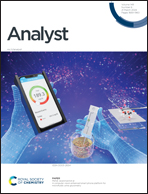Fabrication of well-aligned Co-MOF arrays through a controlled and moderate process for the development of a flexible tetrabromobisphenol A sensor†
Abstract
Tetrabromobisphenol A (TBBPA) has attracted a great deal of attention due to its side effects and potential bioaccumulation properties. It is of great importance to construct and develop novel electrochemical sensors for the sensitive and selective detection of TBBPA. In the present study, cobalt (Co) based metal–organic frameworks (MOFs) were synthesized on carbon cloth (CC) by using cobalt nitrate hexahydrate and 2-methylimidazole. The morphological characterization was carried out by transmission electron microscopy (TEM), scanning electron microscopy (SEM), X-ray diffraction (XRD), X-ray photoelectron spectroscopy (XPS) and Fourier transform infrared spectroscopy (FTIR). The results showed that Co-MOFs/CC have a leaf-like structure and abundant surface functional groups. The electrochemical properties of the sensor were investigated by differential pulse voltammetry (DPV). The effects of different ratios of metal ions to organic ligands, reaction temperature, time, concentration, pH value of the electrolyte, and incubation time on the oxidation peak current of TBBPA were studied. Under the optimal conditions, the linear range of the designed sensor was 0.1 μM–100 μM, and the limit of detection was 40 nM. The proposed sensor is simple, of low cost and efficient, which can greatly facilitate the detection tasks of environmental monitoring workers.



 Please wait while we load your content...
Please wait while we load your content...